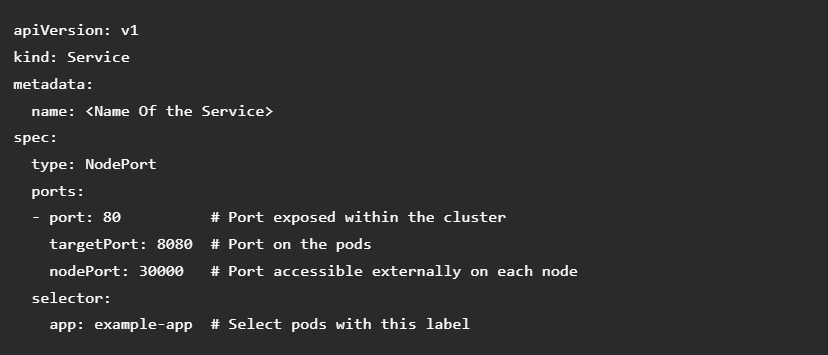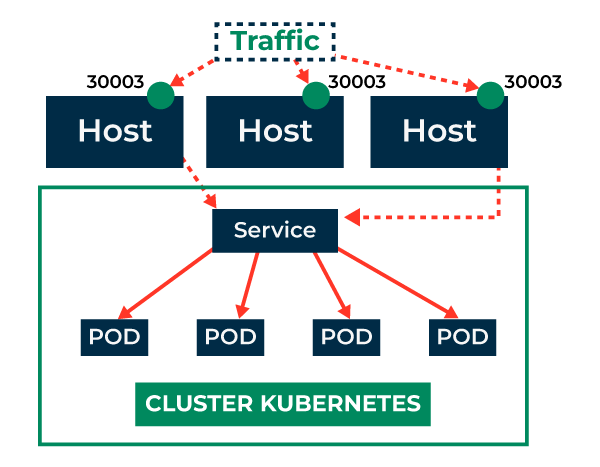In this article, we will explore the Kubernetes NodePort service, a powerful tool for exposing applications and making them accessible to end-users. Kubernetes services play a vital role in enabling communication between pods within a cluster and the outside world. Among the three types of Kubernetes services – ClusterIP, NodePort, and LoadBalancer – the NodePort service stands out by providing both internal and external visibility to the cluster. By assigning a port within a specific range and leveraging nodes with public IP addresses, the NodePort service allows applications to be reached by users over the internet. Additionally, we will delve into the process of creating a NodePort service, including steps such as defining the service in a YAML file and applying the configuration to the Kubernetes cluster. Through sample use cases, we will demonstrate the versatility of the NodePort service and how it can contribute to service discovery and efficient application access in Kubernetes environments.

Overview of Kubernetes NodePort Service
Definition of Kubernetes NodePort service
The Kubernetes NodePort service is a type of service that allows external access to applications running within a cluster. It extends the functionality of the ClusterIP service by providing both internal and external visibility to the cluster.
Purpose of Kubernetes NodePort service
The main purpose of the Kubernetes NodePort service is to expose applications to the internet, allowing end-users to access them. This type of service is particularly useful when you want to make your applications accessible from outside the cluster, such as for public-facing websites or API endpoints.
Additionally, the Kubernetes NodePort service enables communication between pods running within the cluster, making them available to other pods. This allows for seamless integration and collaboration between different components of an application.
Furthermore, the Kubernetes NodePort service can be utilized for service discovery in Kubernetes. It provides an easy way to discover and connect to specific services within the cluster, facilitating efficient communication between components of a distributed system.
Comparison with other Kubernetes services
In Kubernetes, there are three main types of services: ClusterIP, NodePort, and LoadBalancer. While ClusterIP is used for internal communication within the cluster, and LoadBalancer is typically used in cloud environments to distribute traffic, the Kubernetes NodePort service bridges the gap between internal and external accessibility.
Unlike the ClusterIP service, which only provides internal visibility, the Kubernetes NodePort service allows both internal and external access to the cluster. It assigns a port within the range of 30000-32767, and requires nodes to have public IP addresses. This means that applications exposed through a Kubernetes NodePort service can be accessed by clients outside the cluster using the node’s IP address and the assigned port number.
Compared to the LoadBalancer service, which provides dynamic load balancing in cloud environments, the Kubernetes NodePort service offers a more straightforward way to expose applications without relying on specialized load balancing infrastructure. However, it’s important to note that the NodePort service may not be as scalable or feature-rich as the LoadBalancer service when it comes to handling high traffic volumes or complex routing requirements.
Overall, the Kubernetes NodePort service provides a simple and effective method to expose applications in Kubernetes, making them accessible both internally within the cluster and externally to end-users.

When to Use The Kubernetes NodePort Service
Exposing applications to the internet
The NodePort service is an excellent choice when you need to expose your applications to the internet. By mapping a public port to a specified port on the nodes, the service allows external clients to reach the application running within the cluster. This is particularly useful for web applications, APIs, or any other services that need to be accessible from outside the cluster.
Making pods available to other pods
The NodePort service also enables communication between pods running within the cluster. By exposing a specific port on each node, pods can interact with each other using that port. This makes it possible to build distributed systems or microservices architectures where different components need to communicate. It simplifies the process of integrating and sharing data between pods, promoting collaboration and flexibility in application development.
Service discovery in Kubernetes
Another use case for the NodePort service is service discovery in Kubernetes. When running multiple services within a cluster, it can be challenging to keep track of their locations and dynamically discover and connect to the right service. The NodePort service provides a solution by exposing a specific port on each node for each service. This means that other pods or components can easily discover the exposed service by querying the node’s IP address and the assigned port. This simplifies the task of service discovery and facilitates seamless communication between different parts of a distributed system.
How to Use NodePort Service
Creating a YAML file for NodePort service
To use the NodePort service in Kubernetes, you need to create a YAML file that specifies the desired configuration for the service. This configuration file will define the necessary properties and settings for the service, such as the port range, the target port, and any other relevant specifications.
Defining port and target port configuration
In the YAML file, you will need to define the port and target port configuration for the NodePort service. The port represents the port number that clients will use to connect to the service, while the target port specifies the port on the pods to which traffic should be forwarded. By specifying these ports, you can control how the service routes incoming requests to the appropriate pods within the cluster.
Exposing pods to other nodes in the cluster
One of the key features of the NodePort service is its ability to expose pods to other nodes within the cluster. By designating a specific port on each node for the service, pods running on different nodes can communicate with each other using that port. This promotes seamless integration and collaboration between different components of an application, facilitating the development of distributed systems or microservices architectures.
Enabling external access to the application
The NodePort service also allows for external access to the application running within the cluster. By mapping a public port to the assigned port on the nodes, the service enables clients outside the cluster to reach the application using the node’s IP address and the assigned port number. This makes it possible to expose web applications, APIs, or any other services to end-users or external systems, providing the necessary connectivity and accessibility.

Sample Use Cases for the Kubernetes NodePort Service
Web application deployment
One of the common use cases for the NodePort service is the deployment of web applications. By exposing the application through a specific port on each node, the service makes the application accessible to external users. This is particularly useful for public-facing websites or APIs that need to be accessible from the internet. The NodePort service simplifies the process of exposing and managing web applications in Kubernetes, providing a straightforward and effective method for deployment.
Microservices architecture
The NodePort service is also well-suited for building microservices architectures in Kubernetes. By exposing specific ports on each node, pods running on different nodes can communicate with each other, promoting collaboration and flexibility in application development. This allows for the creation of distributed systems composed of independent, loosely-coupled services that can easily scale and evolve. The NodePort service simplifies the process of connecting and integrating different microservices, making it easier to build and manage complex architectures.
Testing and development environments
Another use case for the NodePort service is in testing and development environments. By exposing applications through specific ports on each node, developers can easily test and access their applications from their local machines. This makes it simple to debug, iterate, and deploy changes to the application, as it allows for direct interaction with the running instances. The NodePort service provides an accessible and convenient way to set up testing and development environments in Kubernetes, enabling efficient application development and iteration.
In conclusion, the Kubernetes NodePort service is a valuable tool for exposing applications to the internet, making them available to external users. It also facilitates communication between pods within a cluster and provides a solution for service discovery. By following the appropriate steps to create and configure a NodePort service, you can leverage its capabilities in various use cases, such as web application deployment, microservices architectures, and testing and development environments. With its simplicity and effectiveness, the NodePort service empowers developers to build and manage scalable and accessible applications in Kubernetes.




